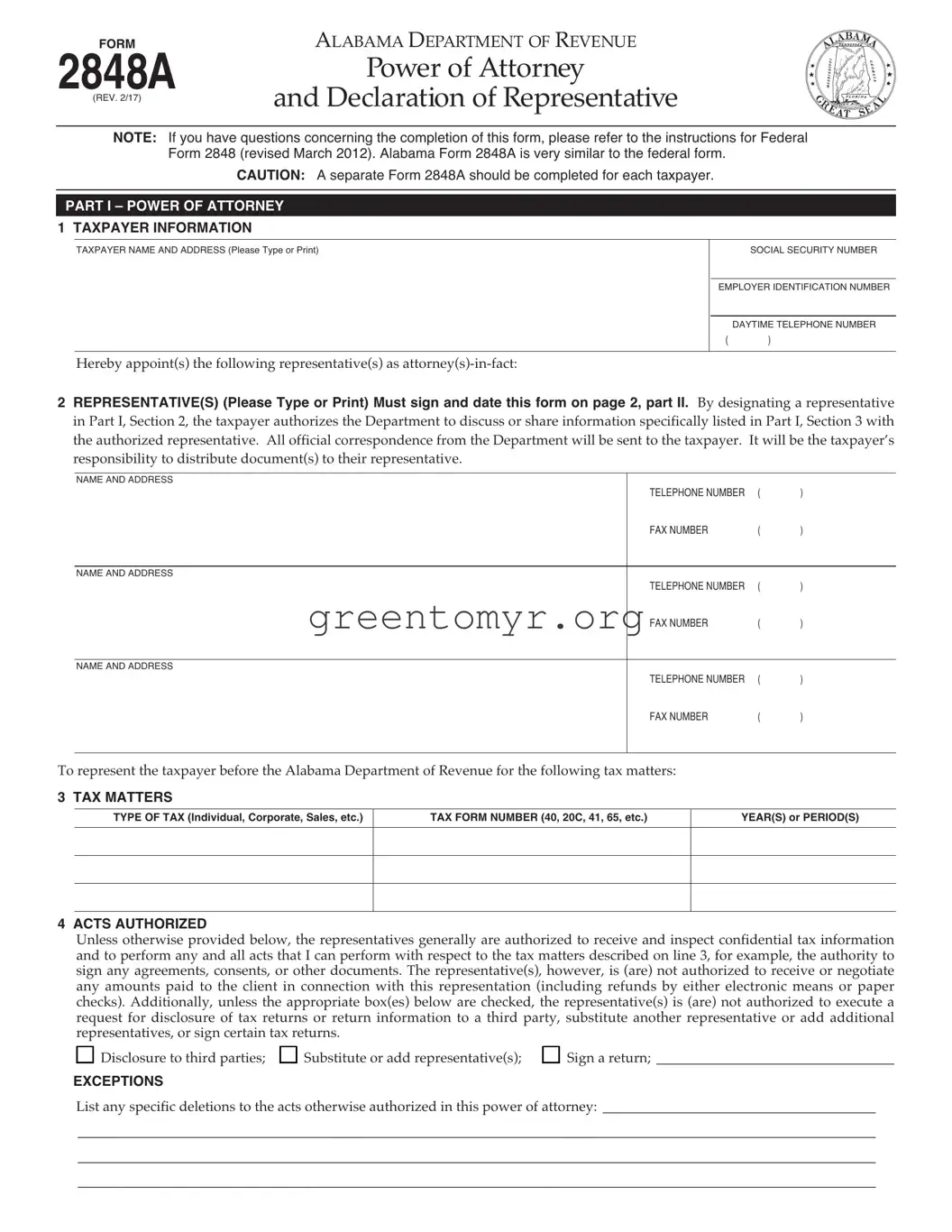FORM 2848A (REV. 2/17) |
PAGE 2 |
5 RETENTION / REVOCATION OF PRIOR POWER(S) OF ATTORNEY |
|
The filing of this power of attorney automatically revokes all earlier power(s) of attorney on file with the Alabama |
|
Department of Revenue for the same tax matters and years or periods covered by this document. If you do not want |
|
to revoke a prior power of attorney, check here |
6 SIGNATURE OF TAXPAYEou MuStR AttAch A copY oF ANY power oF AttorNeY You wANt to reMAIN IN eFFect.
If a tax matter concerns a year in which a joint return was filed, the husband and wife must each file a separate power of attorney even if the same representative(s) is (are) being appointed. If signed by a corporate officer, partner, guardian, tax matters partner, executor, receiver, administrator, or trustee on behalf of the taxpayer, I certify that I have the authority to execute this form on behalf of the taxpayer.
If this power of attorney is not signed and dated, it will be returned to the taxpayer.
SIGNATURE |
DATE |
TITLE (If Applicable) |
|
|
|
PRINT NAME |
|
|
Under penalties of perjury, I declare that:
• I am not currently under suspension or disbarment from practice before the Internal Revenue Service;
• I am aware of regulations contained in Treasury Department Circular No. 230 (31 CFR, Part 10), as amended, concerning the practice of attorneys, certified public accountants, enrolled agents, enrolled actuaries, and others;
• I am authorized to represent the taxpayer identified in Part I for the tax matter(s) specified there; and
• I am one of the following:
Attorney – a member in good standing of the bar of the highest court of the jurisdiction shown below.
a. Certified Public Accountant – duly qualified to practice as a certified public accountant in the jurisdiction shown below. b. Enrolled Agent – enrolled as an agent under the requirements of Treasury Department Circular No. 230.
c. Officer – a bona fide officer of the taxpayer’s organization. d. Full-Time Employee – a full-time employee of the taxpayer.
e. Family Member – a member of the taxpayer’s immediate family (i.e., spouse, parent, child, brother, or sister).
f. Enrolled Actuary – enrolled as an actuary by the Joint Board for the Enrollment of Actuaries under 29 U.S.C. 1242 (the g. authority to practice before the Service is limited by section 10.3(d)(1) of Treasury Department Circular No. 230).
Unenrolled Return Preparer – an unenrolled return preparer under section 10.7(c)(1)(viii) of Treasury Department Circular h. No. 230.
Registered Tax Return Preparer – registered as a tax return preparer under the requirements of section 10.4 of Circular 230.
i. Your authority to practice before the Internal Revenue Service is limited. You must have been eligible to sign the return under examination and have signed the return. See Notice 2011-6 and Special rules for registered tax return preparers and
StudentunenrolledAttorneyand returnor CPApreparers– receivesin permissionthe in tructitopracticens. before the IRS by virtue of his/her status as a law, business, or j. accounting student working in LITC or STCP under section 10.7(d) of Circular 230. See instructions for Part II for additional
information and requirements.
Enrolled Retirement Plan Agent – enrolled as a retirement plan agent under the requirements of Circular 230 (the authority to k. practice before the Internal Revenue Service is limited by section 10.3(e)).
If this declaration of representative is not signed and dated, the power of attorney will be returned.
Note: For designations d-f, enter your title, position, or relationship to the taxpayer in the “jurisdiction” column.


